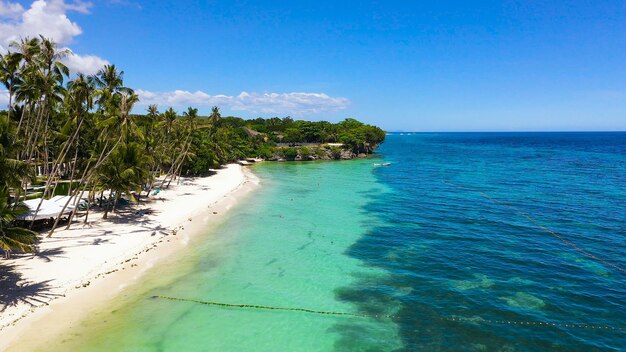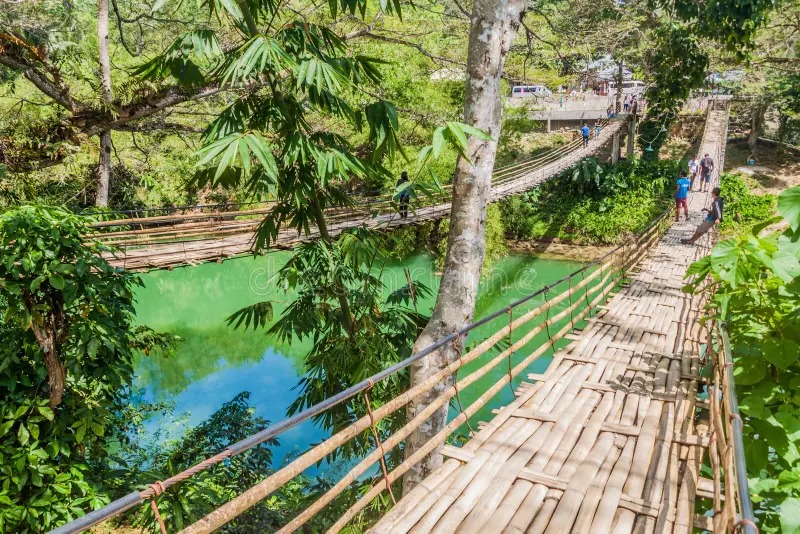
Lisa Maddox
Travel writer
Bohol, Philippines: beaches, forests and chocolate hills
Picture this: over 1,200 perfectly symmetrical, grass-covered mounds stretching across the landscape, transformed into a sea of chocolate-brown hues under the warm summer sun. Welcome to Bohol – a Philippine paradise where the famed Chocolate Hills are just the beginning of an extraordinary adventure waiting to unfold. As the gentle breeze carries whispers of ancient legends about heartbroken giants, you’ll find yourself immersed in one of Southeast Asia’s most captivating destinations.
Beyond these geological wonders, Bohol offers pristine beaches that rival the best in the world, lush forests where the endangered tarsier finds refuge, and a culture rich with warmth and hospitality. Whether you’re climbing the 200+ steps at the Chocolate Hills Complex for breathtaking panoramic views, ziplining across verdant landscapes, or simply exchanging smiles with locals while practicing your “Maayong adlaw” (Good day), this island promises unforgettable experiences at every turn.
In this guide, we’ll take you through everything you need to know about Bohol’s magical Chocolate Hills, help you plan the perfect trip, share essential travel tips, explain how to navigate the island, and reveal the complete Bohol experience that goes far beyond its famous mounds. Let’s embark on a journey through this tropical wonderland where nature’s creativity knows no bounds.
Discover the Magical Chocolate Hills: Bohol’s Natural Wonder

The Formation and Fascinating Geology Behind 1,200+ Symmetrical Mounds
The Chocolate Hills, locally known as “Mga Bungtod sa Tsokolate,” represent one of the Philippines’ most extraordinary geological wonders. This remarkable formation consists of approximately 1,260 to 1,776 perfectly-shaped conical hills spread across more than 50 square kilometers of Bohol’s landscape.
These distinctive mounds originated millions of years ago during the Late Pliocene to Early Pleistocene epochs when the entire area was submerged beneath the Bohol Sea. Marine limestone accumulated over time as vibrant coral reefs flourished in these ancient waters. Through tectonic activity, these underwater formations were gradually elevated, creating a limestone plateau.
The hills’ unique conical shape resulted from a meticulous natural process of limestone dissolution and erosion. Rainwater, which naturally dissolves calcium carbonate, sculpted these limestone deposits over millennia into their current haycock-shaped appearance. Standing between 30 to 50 meters tall, these hills are covered with lush green vegetation that turns chocolate-brown during the dry season – hence their appetizing name.
Recognized as a national geological monument in 1988, the Chocolate Hills have been proposed for UNESCO World Heritage status, highlighting their global significance as a natural wonder.
Best Viewpoints: Chocolate Hills Complex vs. Sagbayan Peak
Visitors to Bohol have two primary options for experiencing the magnificent panorama of the Chocolate Hills:
Chocolate Hills Complex in Carmen: This is the main and most popular viewing area, offering expansive vistas across the greatest concentration of hills. The complex features well-maintained viewing platforms that allow tourists to appreciate the symmetrical beauty and vast scale of this natural phenomenon.
Sagbayan Peak: An alternative viewpoint that provides a different perspective of the hills. While perhaps less frequented than the Carmen complex, Sagbayan Peak offers equally stunning views and might appeal to travelers seeking a less crowded experience.
Both locations serve as gateways to this extraordinary landscape, with each offering distinct advantages depending on your preference for crowd levels and specific viewing angles.
Local Legends and Mythology That Enhance the Hills’ Mystique
The Chocolate Hills are steeped in fascinating folklore that adds cultural depth to their natural splendor. Local legends typically involve giants as the creators of these unusual formations.
One popular myth tells of a heartbroken giant who cried massive tears that, upon drying, formed the hills. Another tale speaks of two warring giants who hurled boulders, rocks, and sand at each other for days, forgetting to clean up their battlefield when they finally made peace – leaving behind the mounds we see today.
These enchanting stories reflect the cultural significance of the Chocolate Hills to Bohol’s people, who have integrated this natural wonder into their heritage and identity. The mythological dimension enhances visitors’ experience, inviting them to see the landscape not just as a geological formation but as a canvas for human imagination and storytelling.
Now that we’ve explored the natural wonder of the Chocolate Hills, their fascinating geological origins, and the rich mythology surrounding them, let’s look at planning your perfect trip to Bohol so you can experience this marvel firsthand.
Planning Your Perfect Trip to Bohol

Now that we’ve explored the magical Chocolate Hills, Bohol’s most famous natural wonder, it’s time to plan when you should visit this enchanting Philippine island to make the most of your experience.
Ideal Visiting Times: Dry Season Advantages (December-May)
For the optimal Bohol experience, plan your visit during the dry season which runs from December through May. During these months, you’ll enjoy:
Consistent sunshine with minimal rainfall
Temperatures averaging between 26 and 29 degrees Celsius
Better visibility for viewing the Chocolate Hills
Ideal conditions for beach activities and island hopping
More reliable transportation schedules without weather disruptions
The dry season provides the perfect climate for exploring all of Bohol’s attractions, from the hills to the beaches of Panglao, with comfortable conditions for outdoor activities.
Weather Considerations: Brown Hills in April vs. Lush Green Landscapes
Bohol’s diverse microclimates create interesting seasonal variations that affect how you’ll experience the island:
April (Late Dry Season): This is when the Chocolate Hills truly earn their name, turning a distinctive chocolate-brown color due to the dried grass covering them. Perfect for classic photographs!
Rainy Season: The hills transform into lush, verdant mounds covered with vibrant green vegetation.
Microclimates: Be aware that different parts of Bohol may experience varying weather patterns even during the same season.
Thunderstorms: While the rainy season brings occasional storms, Bohol’s geographic positioning means typhoon risk is minimal compared to other Philippine regions.
Your preference between the iconic brown hills or the verdant green landscape should influence your travel timing.
Avoiding Peak Tourist Seasons and Securing Early Bookings
Tourism in Bohol follows predictable patterns that savvy travelers can navigate:
Peak Seasons: Holiday periods (Christmas, New Year, Easter) see significant increases in visitor numbers
Accommodation Challenges: During peak times, hotels and resorts often reach full occupancy
Price Surges: Expect higher rates for accommodations, tours, and sometimes transportation
Booking Strategy: Secure your accommodations at least 2-3 months in advance if visiting during peak seasons
Off-Peak Advantages: Consider visiting during shoulder seasons for fewer crowds at popular attractions like the Chocolate Hills and tarsier sanctuaries
Early planning is essential, particularly if you intend to participate in popular activities like diving at Balicasag Island or snorkeling around Panglao, as the 100+ diving centers can become fully booked during busy periods.
With your trip timing carefully planned, we’ll next explore the essential practical travel tips for Bohol to ensure you’re fully prepared for this unforgettable island adventure.
Essential Practical Travel Tips for Bohol

Now that we have covered planning your perfect trip to Bohol, let’s dive into some essential practical tips that will make your adventure smoother and more enjoyable.
A. Currency Guide: Where to Use Philippine Peso and ATM Availability
The official currency in Bohol is the Philippine Peso (PHP). While planning your Bohol adventure, it’s important to understand the local currency situation:
Major establishments like hotels, resorts, and larger restaurants in tourist areas may accept credit cards
Smaller vendors, local markets, tricycle drivers, and rural attractions typically only accept cash
ATMs are readily available in Tagbilaran City and popular tourist areas like Alona Beach
It’s advisable to carry sufficient cash, especially when venturing to remote areas like the Chocolate Hills where ATM access may be limited
B. Language Navigation: English, Tagalog, and Basic Bisaya Phrases
Communication in Bohol is relatively straightforward for international travelers:
English is widely spoken, particularly in tourist areas, hotels, and restaurants
Filipino/Tagalog is the national language and commonly understood
The local dialect is Bisaya (Cebuano), and learning a few basic phrases can enhance your experience:
“Salamat” (Thank you)
“Maayong buntag” (Good morning)
“Pila ni?” (How much is this?)
Most signage in tourist areas will be in English, making navigation easier for international visitors.
C. Packing Recommendations for Bohol’s Tropical Climate
Bohol’s tropical climate requires thoughtful packing:
Lightweight, breathable clothing made of natural fabrics like cotton or linen
Sun protection essentials including:
Wide-brimmed hat
High-SPF sunscreen
Sunglasses
Light cover-ups for sun protection
Comfortable walking shoes for exploring the Chocolate Hills and forest areas
Swimwear for beach activities and island hopping
Light rain jacket or poncho, especially if traveling during the wet season
Mosquito repellent for evenings and forest excursions
Modest clothing for visiting churches and rural communities
With these practical tips in mind, next, we’ll see how to navigate transportation options for getting around Bohol and reaching the iconic Chocolate Hills. Understanding these transportation choices will help you maximize your time exploring all that this magical island has to offer.
Getting around

Tricycles are the most common form of transportation for short trips as well as within the towns of Bohol. These three-wheeled vehicles let you explore the island’s culture while offering a handy and budget-friendly way of exploring local attractions. All you need to do is simply wave down a tricycle by the roadside, but make sure to negotiate the fare beforehand to avoid scams.
If you want to explore independently, then renting a scooter or motorbike can be a good option. You can wander off the typical path and uncover hidden gems in the island’s remote areas. You can easily find a rental in tourist spots such as Tagbilaran and Panglao.
For a hassle-free getaway, try joining an organised tour with a local provider. These packages frequently consist of transportation and guided trips to Bohol’s top-rated attractions, allowing you to sit back, unwind, and enjoy the island’s beauty without being concerned about practicalities.
What to pack
Given Bohol’s tropical weather, it’s important that you put on light, breathable clothing that will keep you comfortable and cool. Don’t forget to bring your best bikinis for beach days in the sun, carefree swims, and relaxing dips! High-SPF sunscreen is also important (it really gets hot everywhere in the Philippines!).
Carry insect and mosquito repellent to protect yourself, especially in forested areas. Wearing comfortable shoes is a must when exploring the various terrains of Bohol – but pick something breathable as it can hot.
Beyond the Chocolate Hills: Complete Bohol Experience

Now that we’ve covered how to reach the magnificent Chocolate Hills, let’s explore the countless other attractions that make Bohol a truly complete destination. While the Chocolate Hills are undoubtedly the island’s crown jewel, Bohol offers so much more for travelers seeking adventure, nature, and cultural immersion.
Adrenaline Adventures: Ziplining, ATV Rides and Eco-Hiking Trails
For thrill-seekers visiting Bohol, the Chocolate Hills Adventure Park provides an exhilarating way to experience the iconic landscape from a different perspective. Here you can soar above the hills on ziplines that offer breathtaking aerial views of the natural wonder. The park combines stunning scenery with heart-pumping activities, making it perfect for adventure enthusiasts.
For a more rugged experience, head to Danao Adventure Park, which has established itself as Bohol’s premier adventure destination. The park offers a variety of eco-friendly activities including:
Thrilling zipline rides across deep valleys
Challenging caving expeditions
Hiking trails that wind through pristine forests
Nature lovers can also explore Can-umantad Falls, where hiking trails lead to a tranquil waterfall nestled in lush mountains. After your trek, cool off with a refreshing swim in the clear waters while surrounded by Bohol’s untamed natural beauty.
Must-Visit Nearby Attractions: Bilar Man-Made Forest and Tarsier Sanctuaries
The Bilar Man-Made Forest stands as a testament to Bohol’s commitment to environmental conservation. This striking two-kilometer stretch of perfectly aligned mahogany trees creates a cathedral-like atmosphere as the dense canopy forms a tunnel of greenery over the road. Originally planted to combat soil erosion, this forest has become one of Bohol’s most photographed spots and a symbol of successful reforestation.
No trip to Bohol would be complete without visiting the Tarsier Sanctuary in Corella. Home to one of the world’s smallest primates, this conservation area allows visitors to observe these unique creatures in their natural habitat. Remember that tarsiers are extremely sensitive to noise and human presence, so visitors are encouraged to maintain silence and avoid using flash photography.
For water enthusiasts, Hinagdanan Cave in Dauis offers an extraordinary underground experience with its impressive stalactite formations and crystal-clear lagoon perfect for swimming.
Cultural Immersion in Carmen and Sagbayan Towns
Beyond natural attractions, Bohol provides rich opportunities for cultural immersion. In Carmen and Sagbayan, the towns closest to the Chocolate Hills, visitors can connect with local communities and experience authentic Filipino hospitality.
The Cambuhat River and Village Tour offers a glimpse into traditional Boholano life. During this tour, you can:
Learn about local oyster farming practices
Participate in traditional crafts
Enjoy freshly prepared local cuisine
Interact with friendly villagers who maintain time-honored traditions
For history enthusiasts, a visit to the historic Baclayon Church is essential. As one of the oldest churches in the Philippines, this architectural gem from the 1700s houses colonial artifacts and stands as a testament to the island’s rich historical heritage.
Complete your cultural journey with a stop at the Bohol Bee Farm, where you can learn about sustainable farming practices, participate in beekeeping workshops, and enjoy farm-to-table dining featuring organic ingredients grown on-site. Their famous coconut ice cream and other local delicacies provide a perfect sweet ending to your Bohol adventure.

Bohol’s treasures extend far beyond its iconic Chocolate Hills, offering travelers a perfect blend of natural wonders, cultural experiences, and adventure. Whether you’re marveling at the symmetrical mounds that turn chocolate-brown during the dry season, exploring the lush Bilar Man-Made Forest, or observing the adorable tarsiers in their sanctuaries, this Philippine paradise delivers unforgettable memories at every turn.
As you plan your journey to this captivating island, remember that the dry season (December to May) provides optimal conditions for exploration, with February offering particularly clear skies and minimal rainfall. Carry sufficient Philippine Pesos, especially when venturing beyond tourist hubs, and consider learning a few phrases in Bisaya like “Salamat” (Thank you) to connect with locals. Bohol’s perfect balance of accessibility and untouched beauty makes it a must-visit destination for travelers seeking both relaxation and adventure in the heart of the Philippines.
Planning a trip to Bohol? Here are some of our top picks…
Stay: Oceanica Panglao
See: Chocolate Hills
Experience: Marinelife at Pamilacan Island
From Cebu: Bohol day tour

